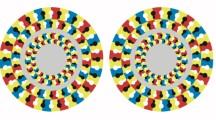Abstract
Adam Pautz (Pautz, Nanay (ed), Current Controversies in philosophy of perception, Routledge, New York and London, 2017, Pautz, Philosophical Issues 30:257–272, 2020) coined the phrase “the Laws of Appearance” for some underappreciated features of perceptual experience. Pautz suggests that the modal status of the Laws presents a puzzle: it is problematic to regard them as necessary, and also problematic to regard them as contingent. This paper presents possible counterexamples to the laws, suggesting that they are contingent as originally stated (Sect. 1). But the laws are readily modified so as to express constitutive features of normal human visual experience, and thus understood they are metaphysically necessary (Sect. 2). Analogous pictorial laws govern representational painting, and these can be explained by appealing to the representational format of the medium (Sect. 3). This invites the question whether there might be format-based explanations of the Laws of Appearance. If so, can the contingency of the format facts be squared with the necessity of the Laws? The paper answers “Yes” to both questions (Sect. 4).
Similar content being viewed by others
Notes
Since a single surface can be multi-colored, we might prefer to hear this as saying that one cannot represent the same area as both pure blue and pure green at the same time.
Those who are skeptical that experiential content takes a propositional form (properly described using a full sentential that-clause complement) can regard these laws as slightly modified: visually, you cannot represent color without representing extension, and all perception represents perspectival information (however that may be analyzed).
In both expositions of the puzzle, Pautz begins by posing it as one for representationalists about perception, but concludes by saying it’s a puzzle for all theorists of vision (2017: 39, 2000: 270).
See https://en.wikipedia.org/wiki/Chameleon_vision. Birds and horses are further possible candidates for counterexamples to Exclusion, thanks to the bilateral character of their vision.
I have kept as close as possible to Pautz’s formulation. The overall form in each case is: ☐(∀x(Fx → Gx)).
These observations are oversimplified, ignoring color contrasts and the many ways of representing distance.
We do not have to accept everything Berkeley says about whether distance is represented in vision (it is “a line directed endwise to the eye”) to agree that distance and direction are represented in different ways.
The view that perceptual format is iconic, as opposed to discursive, must accordingly re-interpret “iconic” in functional terms that do not require pictures in the head. For a recent discussion of the long-standing iconic versus discursive debate concerning perceptual format, see Quilty-Dunn (2019).
One should not infer from the fact that some neural elements have multiple contents that the contents are always processed together. “Place cells” (e.g. Jeffery 2007), and so-called “grandmother cells” (e.g. Gross 2002; Quiroga et al., 2005) respond to a complex of features (at the limit, features jointly specific to a single individual place or object), but the several features are also represented independently in the brain.
More exactly, the truth of the pictorial laws*, since they are stated with a wide scope necessity operator.
Once again, this oversimplifies the complexity of color contrast effects and specific painterly techniques.
References
Dretske, F. (2003). Experience as representation. Philosophical Issues, 13, 67–82.
Fougnie, D., & Alvarez, G. A. (2011). Object features fail independently in visual working memory: Evidence for a probabilistic visual-store model. Journal of Vision, 10, 1–11.
Green, J., & Quilty-Dunn, J. (2020). What is an object file? British Journal for Philosophy of Science, 00, 1–37.
Gross, C. G. (2002). Genealogy of the ‘grandmother cell.’ The Neuroscientist, 8(5), 512–518.
Jeffery, K. J. (2007). Integration of the sensory inputs to place cells: What, where, why, and how? Hippocampus, 17, 775–785.
Luck, S. J., & Vogel, E. K. (1997). The capacity of visual working memory for features and conjunctions. Nature, 390, 279–281.
Pautz, A. (2017). Experiences are representations: An empirical argument. In B. Nanay (Ed.), Current Controversies in philosophy of perception (pp. 23–42). New York and London: Routledge.
Pautz, A. (2020). The puzzle of the laws of appearance. Philosophical Issues, 30, 257–272.
Quilty-Dunn, J. (2019). Perceptual pluralism. Noûs, 54, 807–838.
Quiroga, R., Reddy, L., Kreiman, G., Koch, C., & Fried, I. (2005). Invariant visual representation by single neurons in the human brain. Nature, 435(7045), 1102–1107.
Sone, H., Li, A., & Fukada, K. (2019). Simultaneous recall procedure reveals integrated object representations in VWM. Journal of Vision, 19, 202.
Acknowledgements
This work was first presented online in Laurenz Casser’s MindWorks series. My thanks to Laurenz, Brad Saad, Ting Fung Ho and in particular to Adam Pautz for comments on that occasion. I would also like to thank this journal’s two very helpful referees.
Funding
No special sources of funding.
Author information
Authors and Affiliations
Corresponding author
Ethics declarations
Conflict of interest
No conflicts of interest. The author has no relevant financial or non-financial interests to disclose.
Additional information
Publisher's Note
Springer Nature remains neutral with regard to jurisdictional claims in published maps and institutional affiliations.
Rights and permissions
About this article
Cite this article
Sainsbury, M. Visual Experience and The Laws of Appearance. Erkenn 88, 2933–2940 (2023). https://doi.org/10.1007/s10670-021-00484-9
Received:
Accepted:
Published:
Issue Date:
DOI: https://doi.org/10.1007/s10670-021-00484-9



